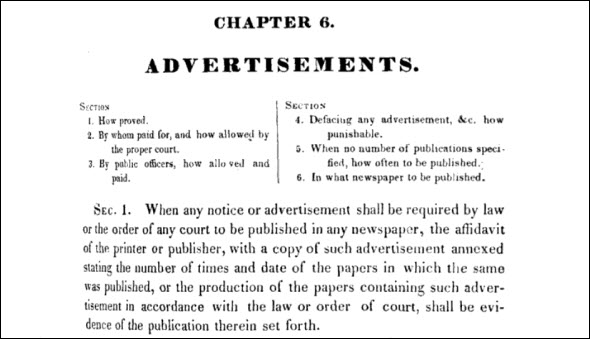A lesson from Arkansas law
It is one of the most basic elements of the law.
You can’t do something about an issue if you don’t know about it.
And so the law makes people who want you to have to do something — or who want to do something to you — post notice about it.
So, yesterday, The Legal Genealogist offered up sources for early Arkansas laws, since this weekend is the 2019 Fall Seminar of the Arkansas Genealogical Society in Benton.1 And one of those sources is a compiled set of laws of the Territory of Arkansas, published in 1835 as the Laws of Arkansas Territory.2
Looking through those early laws — organized in alphabetic order from Abatement through Writs and Process — one that caught my eye was Chapter 6, Advertisements.3

That’s the statute that talks about those legal notices that are in all those newspapers — you know, the ones our eyes often skim over. It talks about the fact that they’re required to be published, and how to prove publication, and who has to pay for them and where they have to be published.
In other words, it talks about notice: how you tell people something has to be done or that you’re about to do something to them.
And they are, quite simply, genealogical gems.
Looking just at the Weekly Arkansas Gazette of 26 January 1842, there’s a lot to be learned from the legal notices required to be published because of laws like Chapter 6 of the Laws of Arkansas Territory:
• In 1838, Matthias Illium mortgaged 200 acres of land in Pulaski County, Arkansas, to Josiah Gould. He hadn’t paid up and, in the interim, had allowed the felling of lumber on the land, reducing the value of the land. So Gould sued to block the lumbering and to foreclose on the mortgage. The action was not only against Illium but against his unknown heirs, with an administrator appointed to represent the estate.4
• William Field was the owner of one-fifth of a tract of land near Little Rock formerly owned by Bernard Smith, deceased, and of a one-fifth interest in notices executed for the lease of the land, and agent for the Smith heirs. Anybody who wanted to settle any of Smith’s affairs had to deal with Field.5
• On 5 November 1839, William Phillips bought 80 acres in Jefferson County at a sheriff’s sale, where it had gone on the block for non-payment of taxes. He paid a whopping $2.25 for the land and wanted the court to confirm his title. Anybody who didn’t like it, well, they had to show up in court and “show cause why the sale so made should not be confirmed.”6
• On 29 December 1841, Samuel M. Rutherford was issued letters testamentary by the Probate Court in Pulaski County as executor of the estate of George H. Burnett. Anybody who had any claim against the estate had a year to submit the claim or “be for ever barred, and precluded from any benefit in the said estate.”7
Every one of these helps tell the story of a life. It may point to additional records — and it may be the only record that exists if there was a courthouse fire or flood or other records loss in the place where it should have been recorded.
Taking notice of the legal notices helps us do that reasonably exhaustive research we all need to do.
Cite/link to this post: Judy G. Russell, “Taking notice,” The Legal Genealogist (https://www.legalgenealogist.com/blog : posted 17 Oct 2019).
SOURCES
- Judy G. Russell, “Finding the law in the Natural State,” The Legal Genealogist, posted 16 Oct 2019 (https://www.legalgenealogist.com/blog : accessed 17 Oct 2019). ↩
- J. Steele and J. McCampbell, editors, Laws of Arkansas Territory (Little Rock : J. Steele, 1835); digital images, Google Books (https://books.google.com/ : accessed 16 Oct 2019). ↩
- “Advertisements,” Chapter 6 in ibid., 99-100. ↩
- “Legal Advertisements,” Gould v. Lawson, Administrator, Weekly Arkansas Gazette, 26 January 1842, p. 1, col. 1; digital images, Newspapers.com (https://www.newspapers.com/ : accessed 17 Oct 2019). ↩
- Ibid., “Notice,” p. 1, col. 2. ↩
- Ibid., “Notice is Hereby Given,” p. 1, col. 2. ↩
- Ibid., “Executor’s Notice,” p. 1, col. 2. ↩



Sometimes those notices are the only evidence you have that someone has died.
I love legal notices. It’s often the first time I’m aware there could be a court record available. This is especially helpful in the time period or location where FamilySearch hasn’t filmed the records. Big shout out to newspapers being digitized so we can find these notices!